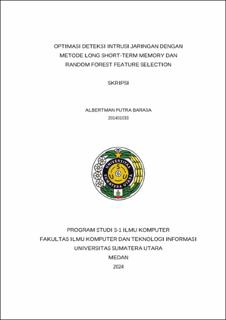Optimasi Deteksi Intrusi Jaringan dengan Metode Long Short-Term Memory dan Random Forest Feature Selection
Optimization of Network Intrusion Detection with Long Short-Term Memory Method and Random Forest Feature Selection

Date
2024Author
Barasa, Albertman Putra
Advisor(s)
Handrizal
Nurahmadi, Fauzan
Metadata
Show full item recordAbstract
Network intrusion detection is a crucial aspect of information security aimed at identifying suspicious behavior within network traffic. However, with technological advancements and the increasing need of data, data processing becomes a significant challenge in intrusion detection. Therefore, this research examines the development of a network intrusion detection system using Long Short-Term Memory (LSTM) methods combined with Random Forest-based feature selection to address the challenges of managing large and complex network data. The use of Random Forest Feature Selection (RFUTE) aims to enhance accuracy by reducing data dimensions. In this study, RFUTE successfully selected 29 features for binary classification and 30 features for multiclass classification from a total of 43 available features. The system was tested using the NF-UQ-NIDS-v2 dataset and the evaluation results indicate that the application of RFUTE significantly improved the performance of the LSTM intrusion detection model. The result showed that Classification Report for binary classification achieved an average of 99%, while multiclass classification increased from an average of 88% to 95%. Additionally, the AUC-ROC curve of the model with RFUTE showed better performance compared to the model without RFUTE, with an increase in AUC to 0.999 for binary classification and 0.9987 for multiclass classification. These findings indicate that the LSTM method with RFUTE is not only effective in enhancing accuracy and prediction performance but also relevant for application in large-scale and complex network intrusion detection environments.
Collections
- Undergraduate Theses [1253]
